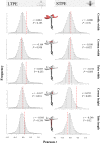Direct evidence supporting Darwin's hypothesis of cross-pollination promoted by sex organ reciprocity
- PMID: 35596603
- PMCID: PMC9546006
- DOI: 10.1111/nph.18266
Direct evidence supporting Darwin's hypothesis of cross-pollination promoted by sex organ reciprocity
Abstract
The floral phenotype plays a main role in the attraction and fit of pollinators. Both perianth traits and the positioning of sex organs can be subjected to natural selection and determine nonrandom mating patterns in populations. In stylar-polymorphic species, the Darwinian hypothesis predicts increased mating success between individuals with sex organs at equivalent heights (i.e. with higher reciprocity). We used paternity analyses in experimental populations of a stylar-dimorphic species. By comparing the observed mating patterns with those expected under random mating, we tested the effects of sex organ reciprocity and perianth traits on mating success. We also analysed phenotypic selection on perianth traits through female and male functions. The (dis)similarity of parental perianth traits had no direct effects on the mating patterns. Sex organ reciprocity had a positive effect on mating success. Narrow floral tubes increased this effect in upper sex organs. Perianth traits showed little signs of phenotypic selection. Female and absolute fitness measures resulted in different patterns of phenotypic selection. We provide precise empirical evidence of the Darwinian hypothesis about the functioning of stylar polymorphisms, demonstrating that mating patterns are determined by sex organ reciprocity and only those perianth traits which are critical to pollinator fit.
Keywords: Narcissus papyraceus; cross-pollination; floral traits; mating patterns; phenotypic selection; sex organ reciprocity; stylar polymorphism.
© 2022 The Authors. New Phytologist © 2022 New Phytologist Foundation.
Figures




Similar articles
-
Disassortative mating prevails in style-dimorphic Narcissus papyraceus despite low reciprocity and compatibility of morphs.Evolution. 2015 Sep;69(9):2276-88. doi: 10.1111/evo.12731. Epub 2015 Aug 20. Evolution. 2015. PMID: 26200739
-
The role of short-tongued insects in floral variation across the range of a style-dimorphic plant.Ann Bot. 2013 Feb;111(2):317-28. doi: 10.1093/aob/mcs261. Epub 2012 Dec 5. Ann Bot. 2013. PMID: 23223205 Free PMC article.
-
The evolution of polymorphic sexual systems in daffodils (Narcissus).New Phytol. 2005 Jan;165(1):45-53. doi: 10.1111/j.1469-8137.2004.01183.x. New Phytol. 2005. PMID: 15720619 Review.
-
Asymmetrical mating patterns and the evolution of biased style-morph ratios in a tristylous daffodil.Genet Res (Camb). 2008 Feb;90(1):3-15. doi: 10.1017/S0016672307008956. Genet Res (Camb). 2008. PMID: 18289396
-
Darwin's legacy: the forms, function and sexual diversity of flowers.Philos Trans R Soc Lond B Biol Sci. 2010 Feb 12;365(1539):351-68. doi: 10.1098/rstb.2009.0212. Philos Trans R Soc Lond B Biol Sci. 2010. PMID: 20047864 Free PMC article. Review.
Cited by
-
Convergent evolutionary patterns of heterostyly across angiosperms support the pollination-precision hypothesis.Nat Commun. 2024 Feb 9;15(1):1237. doi: 10.1038/s41467-024-45118-0. Nat Commun. 2024. PMID: 38336937 Free PMC article.
-
Two floral forms in the same species-distyly.Planta. 2023 Sep 1;258(4):72. doi: 10.1007/s00425-023-04229-6. Planta. 2023. PMID: 37656285 Review.
-
FlowerMate: Multidimensional reciprocity and inaccuracy indices for style-polymorphic plant populations.Appl Plant Sci. 2024 Oct 11;12(6):e11618. doi: 10.1002/aps3.11618. eCollection 2024 Nov-Dec. Appl Plant Sci. 2024. PMID: 39628539 Free PMC article.
-
Ecological correlates of population genetics in Linum suffruticosum, an heterostylous polyploid and taxonomic complex endemic to the Western Mediterranean Basin.AoB Plants. 2024 May 21;16(4):plae027. doi: 10.1093/aobpla/plae027. eCollection 2024 Jul. AoB Plants. 2024. PMID: 39005727 Free PMC article.
-
Diverse mating consequences of the evolutionary breakdown of the sexual polymorphism heterostyly.Proc Natl Acad Sci U S A. 2023 Jan 10;120(2):e2214492120. doi: 10.1073/pnas.2214492120. Epub 2023 Jan 3. Proc Natl Acad Sci U S A. 2023. PMID: 36595698 Free PMC article.
References
-
- Abdusalam A, Liao WJ, Zhang ZQ, Li QJ. 2022. Pollinator shifts along an elevation gradient mediate different response in self‐pollination in heterostylous Primula nivalis . Journal of Systematics and Evolution 60: 186–195.
-
- Aedo C. 2013. Narcissus L. (Amaryllidaceae). In: Rico E, Crespo MB, Quintanar A, Herrero A, Aedo C, eds. Flora Ibérica, vol. XX. Liliaceae‐Agavaceae. Madrid, Spain: Consejo Superior de Investigaciones Científicas, 340–397.
-
- de Almeida NM, de Castro CC, de Lima Leite AV, Novo RR, Machado IC. 2013. Enantiostyly in Chamaecrista ramosa (Fabaceae‐Caesalpinioideae): floral morphology, pollen transfer dynamics and breeding system. Plant Biology 15: 369–375. - PubMed
-
- Alves dos Santos I. 2002. Flower‐visiting bees and the breakdown of the tristylous breeding system of Eichhornia azurea (Swartz) Kunth (Pontederiaceae). Biological Journal of the Linnean Society 77: 499–507.
Publication types
MeSH terms
LinkOut - more resources
Full Text Sources

